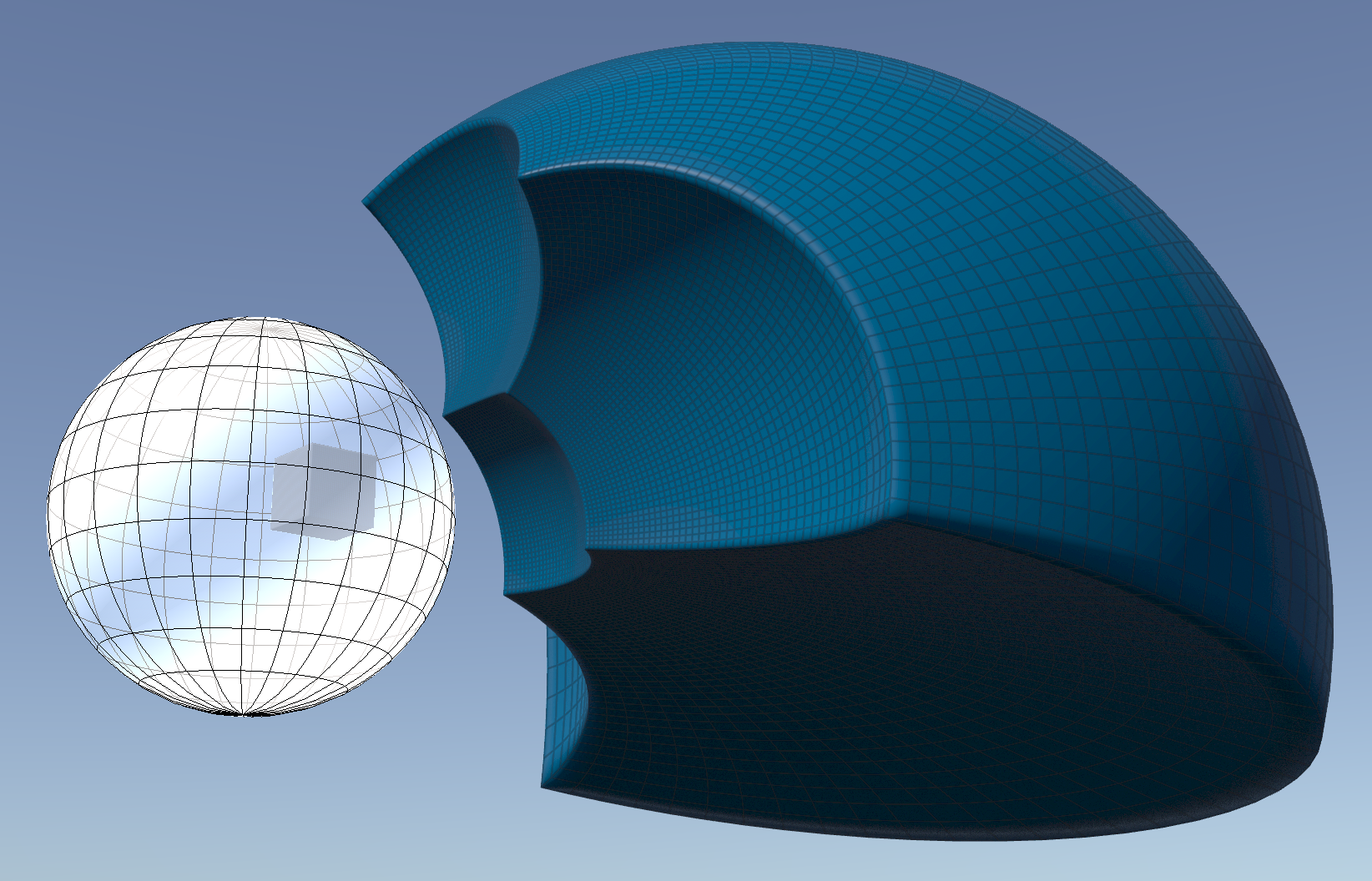Let $M\subset \mathbb{R}^n$ be a domain. A smooth map $f:M \to \mathbb{R}^n$ is called conformal if there is a smooth function $\phi:M\to \mathbb{R}$ and a smooth map $A$ from $M$ into the group $O(n)$ of orthogonal $n\times n$-matrices such that the derivative $f’$ of $f$ satisfies
\[f’=e^\phi A.\]
In the two dimensional case this definition agrees with the one given in an earlier post. It means that when restricting attention to very small regions (i.e. looking through a microscope) $f$ looks like a similarity transformation. The similarity transformations themselves, defined as affine maps of the form
\begin{align*}f:\mathbb{R}^n &\to \mathbb{R}^n \\\\ f(\mathbf{x}) &=e^\phi A \mathbf{x}+\mathbf{b}\end{align*}
with $\phi\in\mathbb{R}$, $A\in O(n)$, $\mathbf{b}\in\mathbb{R}^n$ are standard examples of conformal maps.
The theory of holomorphic functions shows that for $n=2$ there is an abundance of conformal maps $f$ from domains in $M\subset \mathbb{R}^n$ into $\mathbb{R}^n$. In contrast, a famous theorem proved by Liouville in 1850 says that for $n \geq 3$ all such maps $f$ are of the form
\[f= s_1\circ g \circ s_2\]
where $s_1$ and $s_2$ are similarity transformations and
\begin{align*}g:\mathbb{R}^n\setminus\{\mathbf{o}\} &\to \mathbb{R}^n\setminus\{\mathbf{o}\} \\\\ g(\mathbf{x}) &=\frac{\!\!\!\mathbf{x}}{|\mathbf{x}|^2}\end{align*}
is the so-called inversion in the unit sphere $S^{n-1}$. Inversion interchanges the exterior of $S^{n-1}$ with its interior (from which the origin has been removed). All points of $S^{n-1}$ are fixpoints of $g$. For this reason $g$ is also called the reflection in the unit sphere.
Let us prove that $g$ is conformal. For all $\mathbf{x}\in\mathbb{R}^n\setminus\{\mathbf{o}\}$ and $\mathbf{y}\in \mathbb{R}^n$ we have
\begin{align*}g'(\mathbf{x})\,\mathbf{y}&=\frac{\!\!\!\mathbf{y}}{|\mathbf{x}|^2}-\frac{2\langle \mathbf{x},\mathbf{y}\rangle}{|\mathbf{x}|^4}\\\\ &=\frac{\!\!\!1}{|\mathbf{x}|^2}\left(\mathbf{y}-2\left\langle \frac{\mathbf{x}}{|\mathbf{x}|},\mathbf{y}\right\rangle\frac{\mathbf{x}}{|\mathbf{x}|}\right).\end{align*}
Now the map
\[\mathbf{y} \mapsto A\mathbf{y}:=\mathbf{y}-2\left\langle \frac{\mathbf{x}}{|\mathbf{x}|},\mathbf{y}\right\rangle\frac{\mathbf{x}}{|\mathbf{x}|}\]
is reflection in the unit vector $\frac{\mathbf{x}}{|\mathbf{x}|}$ and therefore orthogonal. Thus $g$ is conformal. Here is what happens if we apply $g$ to a small cube inside the unit sphere:

Apparently, all cube faces are mapped to pieces of round spheres. Let us prove this in general: If we have a hyperplane
\[E = \{\mathbf{x}\in \mathbb{R}^n \,|\,\langle \mathbf{x},\mathbf{n}\rangle = d\}\]
with unit normal $\mathbf{n}$ and distance $d\neq 0$ to the origin, then all points $\mathbf{x}\in g(E)$ satisfy
\begin{align*}0&=\left\langle\frac{\!\!\!\mathbf{x}}{|\mathbf{x}|^2},\mathbf{n}\right\rangle -d\\\\&=-\frac{\!\!\!d}{|\mathbf{x}|^2}\left(\left\langle \mathbf{x} -\frac{\mathbf{n}}{2 d},\mathbf{x}-\frac{\mathbf{n}}{2 d}\right\rangle -\frac{1}{4 d^2}\right).\end{align*}
So they lie on the sphere with center $\frac{n}{2d}$ and radius $\frac{2d}$. A similar computation shows that any piece of a sphere or plane that does not contain the origin is mapped onto a piece of another sphere or plane. Since planes can be regarded as limiting cases of spheres, a concise though slightly sloppy way to express this fact is by saying that “$g$ transforms spheres into spheres”.
The inversion in a sphere with center $\mathbf{m}$ and radius $r$ is defined as
\[\mathbf{y}\mapsto \mathbf{m}+\frac{\!\!\!\mathbf{y}-\mathbf{m}}{\left|\mathbf{y}-\mathbf{m}\right|^2}.\]
